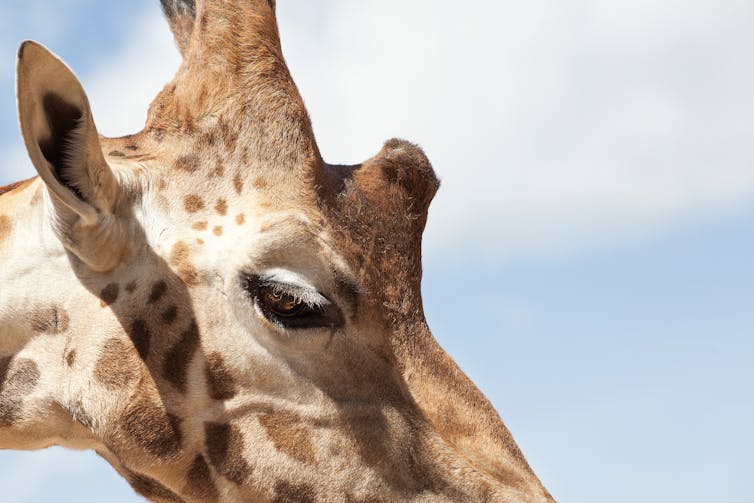The upper eyelid is larger, longer and has deeper roots so it can support more luscious lashes. All mammals have this feature, but why have the eyes developed this way?
The most significant reason is to protect our eyeballs. But having longer top eyelashes can also help us express our feelings and communicate with others.
They protect you
We have between 90 and 160 eyelashes in each upper lid, each of which grow between 8mm and 12mm long. In each lower lid, we have around 75 lashes which grow 6–9mm long.
Together, your long top and shorter bottom lashes provide a curtain of protection that covers the whole eye socket. This stops dust, insects or sweat getting into your eye and hurting it.
Without eyelashes, your eye would also dry out much quicker, and would be more likely to catch nasty germs. This is why people without eyelashes have to blink much more often.
There is actually an “ideal length” for upper eyelashes.
Using eyelash lengths from humans, as well as across a range of animal species, this is one-third the width of the eye. Any shorter and wind gets through too easily. Any longer and the wind starts to become caught under the lashes, with both scenarios causing the eyes to dry out more.
Eyelashes protect animals too
Humans are not the only animals that have eyelashes — all mammals have them, including cats, dogs, elephants, and mice. But they differ in length and density depending on where the animal lives. In most cases, other animals also have much longer lashes on the upper lid.
For animals that live in dusty areas, their eyelashes stop them getting specks of dust in their eyes. This is why camels, kangaroos, elephants and giraffes have several rows of long eyelashes, not just one row.
 Giraffes have long eyelashes to protect their eyes from dust.
Giraffes have long eyelashes to protect their eyes from dust.Evgeny Gubenko/ Shutterstock
In rodents, such as rats, eyelashes are positioned around the eye and act as sensors. That way, rats can protect their eyes by blinking whenever they sense an unknown object near their eyes.
But it’s not just mammals. Birds have also developed eyelash-like feathers around their upper eyelids.
These feathers protect birds’ eyes from sunlight by casting a shadow on their eye. Compared to mammals, these eyelash-like feathers are long (up to 2cm), thick, and widely spaced out.
Other ways eyelashes are useful
Our eyelashes are also important for when we meet and talk to other people.
If you are feeling tired, surprised or concerned, your eyelashes can help someone else tell how you are feeling. Also, fluttering your eyelashes at someone might be a way to indicate you really like them. The extra length of the top eyelashes helps to emphasise this.
 Your eyelashes help you convey emotion.
Your eyelashes help you convey emotion.Maria Spb/ Shutterstock
Lash facts
- Unlike most other hairs in our body, eyelashes don’t have the tiny muscles that make the hairs stand on end, giving us goosebumps
- eyelashes are usually the darkest-coloured hair in our body, and they never go grey!
- the early Egyptians used makeup on their eyelashes, just like many people do today. They lived more than 5,000 years ago
- eyelashes vary a lot between people. Different people can have big differences in the number, thickness, curliness, shape or length of their eyelashes
- lashes curve outwards from the eye so the top and bottom hairs don’t get tangled up when we blink
- if we pull out our eyelashes it takes about eight weeks for them to grow back. So it’s probably best not to!
Christian Moro, Associate Professor of Science & Medicine, Bond University and Zane Stromberga, PhD candidate, Bond University
This article is republished from The Conversation under a Creative Commons license. Read the original article.
